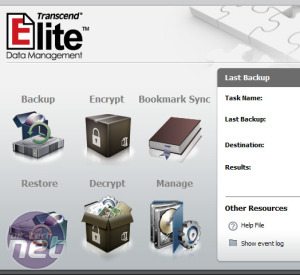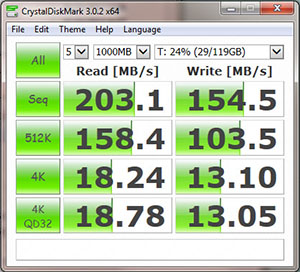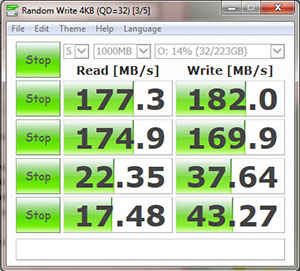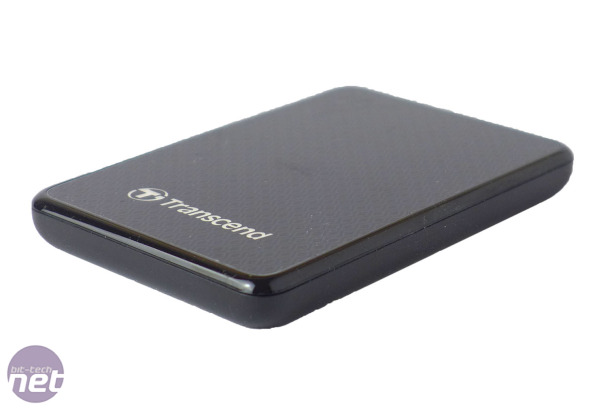
In use the drive is as simple as it comes, with it largely being a totally plug and play experience. You can use it in either USB 3.0 or USB 2.0 ports, with the LED hidden below the top surface illuminating blue for the former or yellow for the latter.
One issue we did encounter was that on our normal test PC the drive would continually disconnect when trying to transfer files larger than about 1GB. These issues with USB 3.0 drives are much documented across a number of different types of drive and different PCs, with suggestions as to the problem being an issue with USB 3.0 controllers (it was fine over USB 2.0), issues with Windows 7 power management and simply dodgy cables. We never did quite get to the bottom of this but the drive worked on all the other machines we tried it with. So if you do pick up this drive and have similar issues, it’s likely not the drive’s fault.
Transcend claims inclusion of a backup utility with the drive but in actual fact it’s just a free download from the company’s website. This software is compatible with the hardware backup button on the drive, though.


As we found with the Transcend StoreJet portable hard drive, which includes the same Elite backup utility, the software is very clunky. It offers the basics, including the ability to encrypt your data, but the interface is not all that clever and the one-touch backup is rendered near useless as you have to manually open the software before the button on the drive will do anything.
Likewise the RecoveRx software that offers data recovery for when you want to reclaim files you’ve deleted from the recycle bin. It does work but is totally hamstrung by the fact you have to specify a file type to search for, and it only has a limited selection. All told, you shouldn’t be buying this drive for its software.
When it comes to performance, though, there’s plenty of reason to be tempted. We ran the SSD test suite Crystal Disk Mark and recorded read speeds of 202MB/s and write speeds of 154MB/s. This was actually faster than a desktop SSD – the SanDisk Extreme 240GB – connected via a USB 3.0 adapter. It returned figures of 182MB/s and 177MB/s. It also, of course, obliterated an external hard drive.


Left: Transcend ESD200 / Right: SanDisk Extreme
The SanDisk drive did prove faster in all the other test random read/write tests though. Nonetheless, the transcend ESD200 certainly holds up to its claim of being a seriously speedy external storage solution.
To test the drive’s sustained read and write speeds we also performed a manual file transfer test, copying 887 files totalling 8.80GB to and from the drive. We were surprised by just how well the drive’s performance held up in this scenario, proving that its performance isn’t just DRAM caching. Its read and write speeds of 151MB/s and 102MB/s keep tabs with the SanDisk, which returned figures of 172MB/s and 114MB/s.
Conclusion
The Transcend ESD200 isn’t setting any new records with either its performance or pocketability but nonetheless it offers genuinely high-end SSD performance in a package that is markedly smaller than a 2.5in SSD. With a price of under £105 it also offers pretty good value for the 128GB model.
It’s a shame Transcend couldn’t match the quality of the drive with the included software, which is hardly worth downloading. But, if you’re after a compact and speedy portable SSD, this is definitely one to keep an eye out for.
One issue we did encounter was that on our normal test PC the drive would continually disconnect when trying to transfer files larger than about 1GB. These issues with USB 3.0 drives are much documented across a number of different types of drive and different PCs, with suggestions as to the problem being an issue with USB 3.0 controllers (it was fine over USB 2.0), issues with Windows 7 power management and simply dodgy cables. We never did quite get to the bottom of this but the drive worked on all the other machines we tried it with. So if you do pick up this drive and have similar issues, it’s likely not the drive’s fault.
Transcend claims inclusion of a backup utility with the drive but in actual fact it’s just a free download from the company’s website. This software is compatible with the hardware backup button on the drive, though.


As we found with the Transcend StoreJet portable hard drive, which includes the same Elite backup utility, the software is very clunky. It offers the basics, including the ability to encrypt your data, but the interface is not all that clever and the one-touch backup is rendered near useless as you have to manually open the software before the button on the drive will do anything.
Likewise the RecoveRx software that offers data recovery for when you want to reclaim files you’ve deleted from the recycle bin. It does work but is totally hamstrung by the fact you have to specify a file type to search for, and it only has a limited selection. All told, you shouldn’t be buying this drive for its software.
When it comes to performance, though, there’s plenty of reason to be tempted. We ran the SSD test suite Crystal Disk Mark and recorded read speeds of 202MB/s and write speeds of 154MB/s. This was actually faster than a desktop SSD – the SanDisk Extreme 240GB – connected via a USB 3.0 adapter. It returned figures of 182MB/s and 177MB/s. It also, of course, obliterated an external hard drive.


Left: Transcend ESD200 / Right: SanDisk Extreme
The SanDisk drive did prove faster in all the other test random read/write tests though. Nonetheless, the transcend ESD200 certainly holds up to its claim of being a seriously speedy external storage solution.
To test the drive’s sustained read and write speeds we also performed a manual file transfer test, copying 887 files totalling 8.80GB to and from the drive. We were surprised by just how well the drive’s performance held up in this scenario, proving that its performance isn’t just DRAM caching. Its read and write speeds of 151MB/s and 102MB/s keep tabs with the SanDisk, which returned figures of 172MB/s and 114MB/s.
Conclusion
The Transcend ESD200 isn’t setting any new records with either its performance or pocketability but nonetheless it offers genuinely high-end SSD performance in a package that is markedly smaller than a 2.5in SSD. With a price of under £105 it also offers pretty good value for the 128GB model.
It’s a shame Transcend couldn’t match the quality of the drive with the included software, which is hardly worth downloading. But, if you’re after a compact and speedy portable SSD, this is definitely one to keep an eye out for.
-
Features25 / 35
-
Performance30 / 35
-
Value25 / 30


MSI MPG Velox 100R Chassis Review
October 14 2021 | 15:04










Want to comment? Please log in.